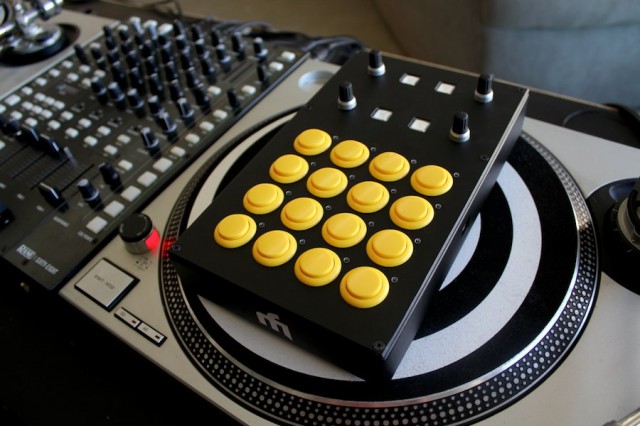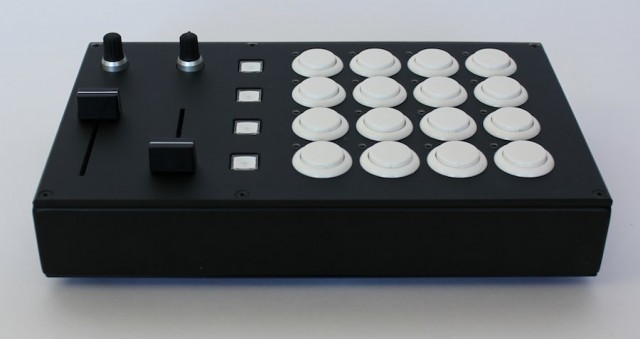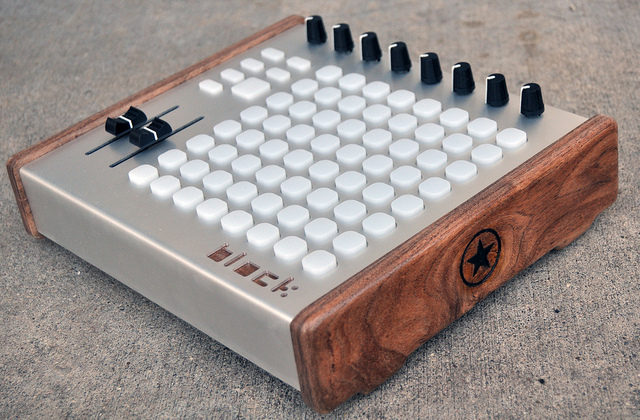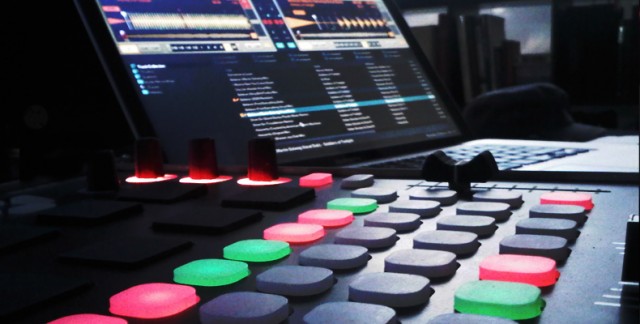What should DJing with a computer look like? We’ve seen over a decade of products that can emulate the vinyl turntable experience, of course. But a native hardware interface for the computer – with all its internal looping, slicing, and effects capabilities – by definition must be different.
DJ TechTools, led by DJ Ean Golden, has mixed writing about technology with designing custom solutions to that problem, interacting with the community on the DJ-centric blog. Ean has released mapping templates for existing hardware, and collaborated on a hardware special edition (Vestax VCI-100) and even a from-the-ground-up product (Novation’s Dicer). I never much liked the term “controllerist,” because the use of MIDI control in computer music is almost as old as real-time music. But what these efforts do is to imagine tangible, touchable interfaces for what the software is doing with the sound.
The custom designs and collaborations culminated in an original boutique controller product, the MIDI-Fighter, a 4×4 grid of mashable arcade buttons. The Midi-Fighter this month gets its first big upgrade: it graduates from being a simple 4×4 set of buttons to adding faders, encoders, and buttons in one of four variations available in the “Pro” series.
Introducing the Midi-Fighter Pro Controllers [DJ TechTools]
The Midi-Fighter Pro will go up against a number of rivals with similar configurations – at their heart, faders + controls + buttons. The Midi-Fighter approach remains unique because of its layer of mapping, but it’s worth considering both the new Pro line and its (friendly) competitors. Together, they’re making what might be considered a new genre of boutique controllers.
Midi-Fighter Pro
Ean Golden announced not one but four variant models in the “Pro” line, replacing what had been a simple 4×4 model. I’m a little partial to the original in some ways – there was a charm to the minimalism of the controller. But these have nice new cases, and of course those additional controllers will come in handy.
The specs:
- US$349 – trade in an existing model to upgrade for $249
- 3 pounds
- MIDI over USB, class-compliant drivers
There are four configurations. They’re pretty similar, differing in fader/knob attributes and mappings.
Beat Masher: Two crossfaders at right angles, one knob (mapped to filter), four preset buttons. Targets Traktor Pro.
XX Fader: Two cross-faders side-by-side, two knobs, four buttons. Targets turntablists.
Cue Master: Looks quite a lot like the XX Fader, but expression faders have multiple parameters in the mappings, and the knobs are dedicated to filter and echo.
Super Knob: Four preset buttons, four knobs, targets Serato cue + effect + sampler controlers or either four-deck or two-deck configurations in Traktor.
The Midi-Fighter line differentiates itself from other grid control rivals in two ways: first, it uses arcade buttons, which have long been loved by DIYers but haven’t seen much (any?) use in commercial music products. Second, the included mappings are heavily DJ-centric and performance-oriented. Other controllers have tended to be more software-agnostic, or, at the opposite extreme, control a range of software functions rather than being configured specifically for performance (as I’d argue is true of the Akai APC and Novation Launchpad for Ableton Live).
To put it more simply, DJ TechTools are the first hardware vendor – big or small – I’ve seen embrace gaming combos as a metaphor for music control. (It makes some sense.) Aside from the aesthetic choice of using game-style arcade buttons, they literally have combos in the fashion of a fighting game – hence the name.
Here’s what that looks like with the “Classic”:
Super Combos – Controllerism meets Street Fighter
And here’s how Ean uses it in his own set, playing with the Pro model with Q-Bert:
Now, a bit on some of the rivals:
Livid’s Block
The Midi-Fighter looks very nice, indeed, but at US$349, it’s getting close to the $399 price of the Livid Block. The two are a study in contrasts. First, the similarities: the Block also combines a grid with continuous (fader/encoder) control, it comes with software for custom mappings, there are custom housing options, and it has plug-and-play USB MIDI that’ll work on any Mac, Windows, or Linux system. (Or iOS, for that matter!) They’re also both boutique controllers produced by independent vendors and made in the US, in collaboration with a community of interested customers. That’s a trend that I think is healthy for this industry as a whole.
Now, some of the differences. The Block has significantly more controls and I/O for your extra $50. You get a light up 8×8 array of pads in place of the 4×4 buttons, additional triggers, and lots of knobs. In fact, I think the Block has the most flexible controller and I/O arrangement of any of its rivals. Add to that MIDI jacks for connecting hardware and expansion jacks, and the Block is powerful.
The Block is still a valid choice for DJs, with Ableton Live and Traktor Pro control templates available (and plenty of customization possible, beyond that).
That’s not to say it’s better than the Midi-Fighter Pro for everyone – some will appreciate the simplicity of the DJ TechTools offering. It’s nice to have different choices.
I covered the addition of expansion on the Block earlier this month:
Control with Room to Grow: Livid Adds Expansion Jacks
(I should also mention the monome, the design of which clearly inspired the grid on the Block. There’s certainly nothing saying you couldn’t combine a monome with other controllers for continuous controls, as many have. Ditto the Novation Launchpad. But I’ll stick to the direct rivals here.)
Electrix Tweaker
Because of its DJ-centric design and marketing, the Tweaker may be of more interest to would-be Midi-Fighter Pro buyers. Like the Block and Midi-Fighter, it combines pads and faders. But it adds a significant twist: velocity-sensitive drum pads.
At the heart of Tweaker lies a grid of 32 rubber pads backlit by RGB LEDs, and 8 velocity sensitive drum pads. There is a channel strip on each side of the grid, and a crossfader centered underneath. Each channel trips is comprised of a fader, three backlit rubber pads, an analog knob, and three push encoders with red LED rings. The navigation section at the top of the unit has a large browsing encoder and a four-way selection push grid (left, right, up, down).
Tweaker is fully USB bus powered and also has MIDI In and Out ports. More info and release date coming soon.
The excellent DJ site Scratchworx has the only shot I’ve seen of a prototype, along with analysis that’s, frankly, better-informed than mine as far as this model — so go check it out!
Electrix are back. The Tweaker cometh…
Other than that, we don’t know much about this beast; stay tuned. My guess is, with the extra controllers, it’ll be significantly more expensive than the other options here.
http://www.electrixpro.com/tweaker.html
Which Controller for You?
These are just a few options. DJ readers, I’d love to hear from you. (And live PA folk, too, for that matter.)
More analysis of the DJTT announcement, also from Scratchworx:
Fighting MIDI and winning – Midi Fighter Pro
(Okay, you’re not really fighting MIDI because it’s a MIDI controller, but … still, it’s a great article!)



